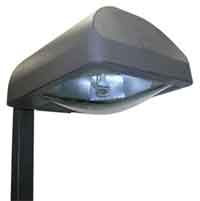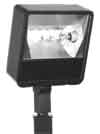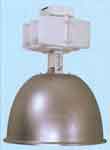HID High Intensity Discharge Lights |
|
Because of new laws banning incandescent and mercury vapor lights, HID lights have become a necessity, not just an option. Energy conservation is another motivating factor in the push toward HID light sources. As fuel costs continue to rise, it is imperative that companies cut their outdoor lighting costs. Because they are controlled by ballasts, HID lights are the ideal fixtures of choice for cities like Houston, Texas, which recently passed an ordinance requiring all outdoor lights to operate at an efficiency of .15 watts per square foot.
HID lights operate by passing a current through a gas tube. A ballast regulates the current, stabilizing electron flow and conserving power in the process. This causes an arc to form within the tube, producing illumination. The two most popular HID lights are high pressure sodium and metal halide lights. High Pressure sodium offers the longest lamp life but creates a yellowish tint to the illumination it produces. Metal Halide (MH) lamps, on the other hand, produce a very bright, white light that is very similar in quality and color rendering ability to natural daylight. MH lamps, however, last for significantly shorter periods of time than HPS lamps, although with new ballast and wiring technology, lamp life is improving as engineering advancements continue to be made.
Generally, we see High Pressure Sodium HID lights used in parking garages where color rendering and aesthetics are not a priority. They also have some limited use in low-level decorative street and park lighting. Here, the slightly colored light they produce can actually compliment ornamental fixtures and special beveled glass lenses to create a surreal sensibility. On the most part, however, Metal Halide lamps continue to gain market dominance as the preferred source of HID lighting. Parking lot lights, standard street lights, and landscape lights all benefit extensively from the level and quality of light these efficient and powerful lamps produce.
RLLD Commercial Lighting carries a wide variety of industrial & commercial lighting fixtures. If you can not find what you are looking for call us toll free at 1-866-654-3961 and we will find it for you. Our home office is located in Houston, Texas with warehouses located throughout the United States that enable us to service all 50 states including Washington D.C., Pittsburgh, Chicago, IL Pennsylvania, (PIT)San Antonio, Tx, Atlanta, GA (ATL), Marina Del Rey & Los Angeles California, Coral Gables, Austin, Texas, Fl, Redmond, Washington (RDM), New York, NY, Memphis, Tennessee (MEM), Madison, WI, (MSN) Dallas, Texas, Portland, Oregon, (PDX) and Stamford, CT. |
Back to main topic: Industrial Lighting
|
| Contact Us |
|
|
| Products |
| Articles |
|
| Information |
|
 HID (High Intensity Discharge) Lights
HID (High Intensity Discharge) Lights
 HID lights make excellent outdoor security lights because they improve peripheral vision in a fashion similar to daylight.
HID lights make excellent outdoor security lights because they improve peripheral vision in a fashion similar to daylight.